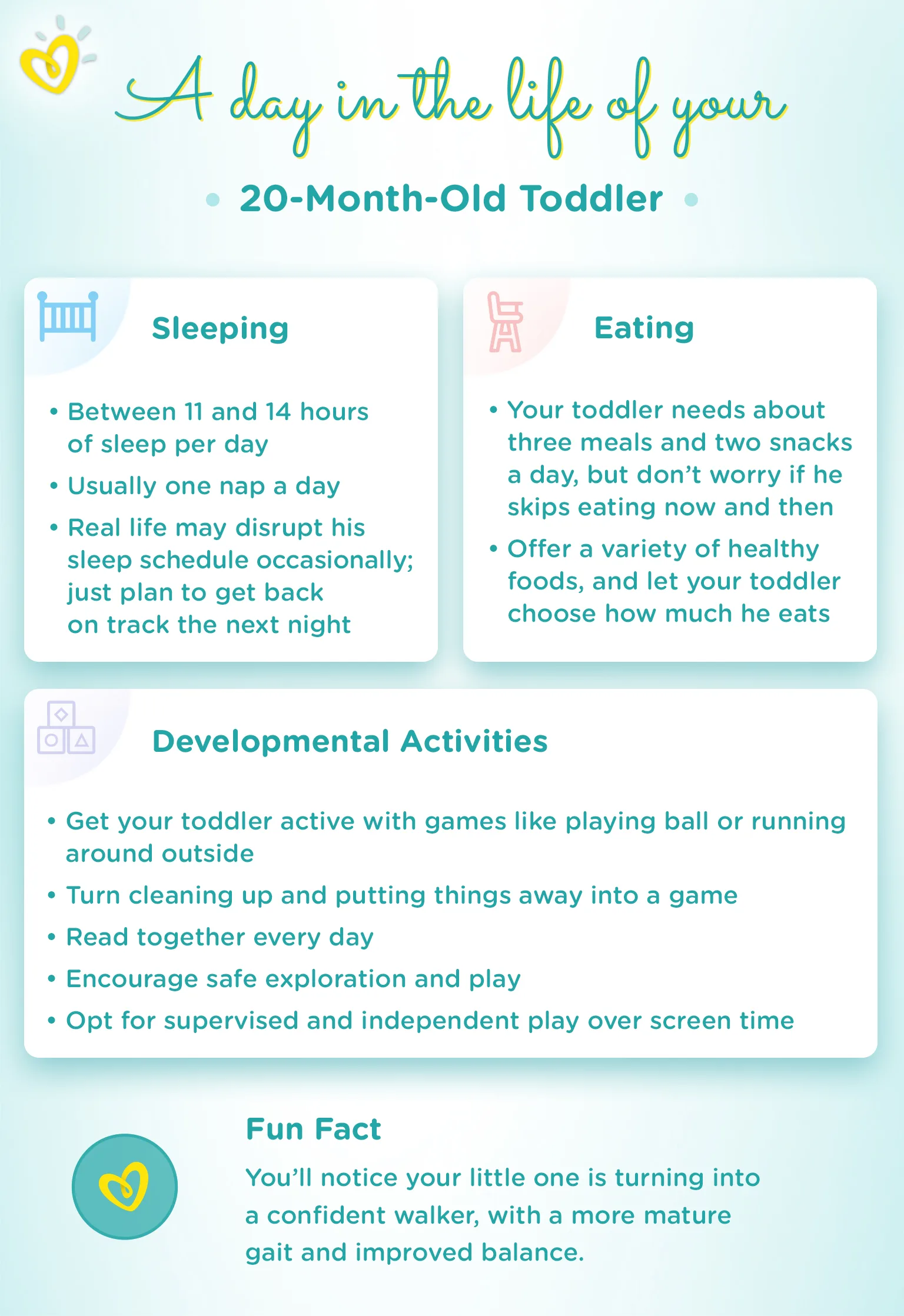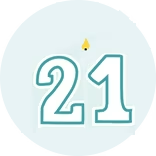20 Month Old Baby Milestones & Development Checklist
By now, your 20 months old baby might have become more active than ever! He is now confidently walking around and busy playing and exploring his little world. But while your 20-month-old baby does these activities, you might witness some instances wherein he gets a little moody or anxious when you leave the house. Nonetheless, your baby at 20 months will always make sure to keep your life busy and happening. If you want to know more about the 20-month baby milestones, along with the challenges and other exciting things, then keep on reading!
20 Months Old Baby Development Milestones
You'll notice your baby at 20 months can do much more than he did in the previous month.
Although each child develops at his own pace, you may notice the following things at in your baby at 20 months:
Separation anxiety may start easing
Your little one may feel anxious from time to time when you leave the room or your home around the 20-month mark. If this happens, give him a quick kiss and a hug and tell him you'll be back soon. The good news is that separation anxiety is only temporary, and chances are it'll start to taper off soon.
Walking progress
Around this time, your toddler will likely become a more skilled and confident walker. You may notice that he has a more mature gait and that he may not be using his hands for balance anymore. He may even walk moving his feet from heel to toe. Before long you'll see some short, stiff runs. Click here to read more about a baby’s walking development.
Acting impulsively.
Toddlers may act impulsively and at this age have little idea of right and wrong or of consequences to actions. It's up to you to help your child learn this in the months and years ahead, but right now your priority is to be extra vigilant, ready to redirect your little one's attention from anything dangerous to something safe. For example, if he's about to reach for a breakable object, swoop in and give him a safe object to play with instead. With firm but gentle guidance and through setting consistent boundaries, over time you can help your little one understand right from wrong, safe from unsafe, and help him get better at self-discipline.
How to Support Your 20-Month-Old Baby’s Development
Help your little one learn and grow with these ideas that help foster your 20-month-old baby’s physical, mental, and emotional development:
Funnel his energy into play and movement:
Your toddler has a lot of energy, and occasionally, when he's frustrated or upset, he may act up. By channeling this pent-up energy into things like running around outside or playing with a ball, you may be able to avoid some of those shows of aggression.
Catch him being good:
Noticing and praising your child for good behaviour is one of the most effective tools you have for managing tantrums and keeping things on an even keel in your house. Your child wants and needs your approval and attention, so make a point of being enthusiastic (without going overboard) when he does something right. You can offer a verbal compliment or even a quick hug to let him know that you're proud of him.
Encourage imaginative, creative play:
Provide some blocks and board books, puzzles and nesting toys; let him build a fort with some chairs and a blanket, or set out some arts and crafts supplies so he can explore different textures and patterns. Whether your little one is playing with a new toy, a safe household object, or making piles of leaves in the garden, he'll love it if you join him and make time to play together.
Let him figure things out:
Playing at this age means exploring and trying things out, and it's fascinating to watch your toddler grapple with what does and what doesn't work. For example, you may see him try to push a toy truck through a space that's too small, or experiment to see which objects will fit into a container. Let him figure it out at his own pace. If he's attempting to build something with blocks or make piles according to shape, you might help him by asking "Does that block have square or round edges?"
Create holiday traditions and family rituals:
Seasonal holidays are great fun to celebrate with a young child, especially when he has an important role to play. For instance, At Diwali, he can help you in decorating the house and making sweets. For patriotic days like Independence Day or Republic day, you can take him for a flag hoisting ceremony. You can take advantage of religious holidays celebrated by your family as opportunities to create your own family routines, rituals, and traditions to bring your family closer together.
Read together every day:
Set aside sometime every day to read with your child. As you read together, ask your toddler to point to pictures of what you're describing. For example, if you're reading a story about a bunny, ask him to point to the bunny on the page. Naming will come next: You'll ask him what he's pointing to, and he'll eventually say "bunny." Even further down the line, he'll learn to name the action taking place on the page. Get him started by doing it yourself, with emphasis and pauses. "See that bunny? That bunny is RUNNING...that bunny is RUNNING very fast."
Mealtimes and Menus for Your 20-Month-Old Baby
As your growing toddler needs a variety of nutritious foods to keep him healthy and strong, offering three small meals and two snacks is a good plan. Make sure he gets enough protein, dairy, whole grains, fruits, and vegetables, which can be spread out across meals. Serve nutritious foods to your little one and let him choose what he wants. Your toddler’s diet will balance out over several days if you offer a range of healthy choices, so don’t worry if you don’t get every food group in at each meal.
Getting Your 20-Months Old Baby Into Veggies
If you’re struggling to get your little one to eat his greens, here are a few tricks you can try:
Eat veggies yourself:
Your little one looks up to you as a role model, so if he sees you eating your vegetables, he is more likely to try it for himself.
Add variety:
Offering veggies of different colors, shapes, and textures can make them more fun for your little one. Perhaps your little one likes mashed potatoes; you could substitute mashed cauliflower occasionally. Or you can mix the veggies with something else, such as broccoli with cheese.
Try dips and sauces:
Get your toddler into veggies by serving them with a tasty sauce or a dip to make the vegetables more appealing.
Top your pizzas:
Kids love pizzas, so why not add some broccoli, peppers, sweet corn, or tomatoes on top. You could even get your toddler involved by letting him add some of the toppings, or you could make a smiley face with the veggie toppings to make it more fun.
Make soup:
Most vegetables make a great soup, either alone or with other veggies. Tomato soup or carrot soup can be really tasty, and your little one may not even realize he’s eating vegetables.
Add veggies to pasta sauce:
Along with pizza, pasta tends to be a kid-favourite food, so you might like to get creative with tasty sauces, packing them with fresh vegetables. Grate some cheese on top and you may find your toddler is eating it with delight.
Offer fruit instead:
If you're striking out with the veggies, you can double up on fruit, which has many of the same important nutrients and fibre.
Sleep Schedule Of A 20-Month-Old Baby
Your 20-month-old baby is likely to need around 11 to 14 hours of sleep per day, and this may include only 1 nap now.
Handling Sleep Disruptions
Although a consistent sleep routine can help your little one sleep better, sometimes disruptions can happen, such as when you're travelling. Here are a few things you can do to help keep your toddler on track and get the rest he needs:
Plan ahead if you can:
If you have a trip or an event coming up that could disrupt your toddler’s usual sleep routine, try to make sure he gets as much rest as possible in the days before. The more rested he is, the more he’ll be able to cope with the schedule changes.
Try to keep disruption to a minimum:
The odd sleep disruption once or twice a month is unlikely to cause any problems, especially if he’s well-rested, but try to limit these as much as possible. Also, keep your child’s temperament in mind, as some children cope better with change than others.
Reset your toddler’s schedule:
If you’ve had a relative visit or you’ve been on vacation, just get back into the usual routine as soon as you can. Put your little one to bed early—even if he complains—so that he gets an extra-long night's sleep; with any luck, you'll be back to normal the next day.
A Day in the Life of Your Little One
What might a day in the life of your 20-month-old baby look like? All toddlers are unique, but your day at home may look something like this:
Your Toddler’s Health and Safety: Screen Time
At this age, your toddler may be curious about screen devices. She's probably seen you on the phone or computer and wondered what you were doing.
The best choice is to prioritize unplugged, creative play as much as possible. Children learn best by playing and interacting with other people and thrive on unstructured playtime both indoors and outside.
If you're thinking of introducing some screen time, here are some guidelines to keep in mind:
Limit and manage screen time:
Create firm and consistent boundaries for things like when, how long, and what type of screen time your little one is exposed to.
Watch with your child:
Whether it's TV, a mobile device, or your computer, stay with your little one and watch together, helping her understand what she is watching.
Select high-quality educational shows, sites, apps, and games:
The quality of what she’s watching matters, so pick shows, websites, apps, or games she can learn from and actively engage with.
Avoid screen time before bed:
Looking at a screen close to bedtime can lead to poor sleep and disrupted sleep schedules, so don’t let your little one have any screen time before bed.
Prioritize real-life play:
Real-life play is the best foundation for your little one’s development, so try to use occasional screen time only as a supplement to her education.
Development Tips for Your Toddler This Month Follow these tips to help your 20-month-old toddler’s development:
Get in tune with your toddler. Every 20-month-old is different: Your child will have a personality that’s unique to them. Instead of comparing them to other children of the same age, support their individuality. In some instances, you may need to discipline your little one, but always avoid raising your voice or resorting to spanking.
Encourage imaginative, creative play. Let your child build a fort with some chairs and a blanket. Or, set out some arts and crafts supplies so they can explore different textures and patterns. Whether your little one is playing with a new toy, a safe household object, or making piles of leaves in the backyard, they’ll love it even more if you join them and make time to play together. All this can help build their imagination.
Read together every day. Set aside some time every day to read with your child. As you read together, ask your toddler to point to pictures of what you’re describing. For example, if you’re reading a story about a bunny, ask them to point to the bunny on the page. Naming will come next: You’ll ask your little one what they’re pointing to, and they’ll eventually say “bunny.” Even further down the line, they’ll learn to name the action taking place on the page. Get them started by doing it yourself, with emphasis and pauses. “See that bunny? That bunny is running…that bunny is running very fast.
Establish routines. Having daily routines gives children structure and provides a sense of comfort and security. So, for example, serve meals and put your child to bed at the same times every day. If one day diverges from the routine, make sure to return to the “normal” routine the next day if possible.
Items You Will Need This Month You may find you’ll need some of the following baby gear this month:
Lightweight stroller. You may be traveling more often now that your little one is mobile. Consider buying a lightweight stroller or an umbrella stroller, both of which are easier to transport than a heavy, standard stroller.
Toddler bed. Your toddler may be able to climb out of their crib now, or at least sometime soon. If that’s the case, it’s time to transition to a toddler bed or to a mattress placed on the floor. Or, if you originally purchased a convertible crib, it’s time to reconfigure it. Use a toddler bed rail to ensure your little one’s safety.
Toddler car seat.Your toddler is getting bigger every day, so keep them safe by checking that their car safety seat is appropriate for their current height and weight. If your child is nearing the car seat manufacturer's upper weight and height limits, you could start looking for a new car seat so that you’re ready when the time comes.
Potty chair. At 20 months old, potty training may be on the horizon, and a potty chair can be helpful. You may want to let your child choose the one they like. It’s a good idea to leave it out in the bathroom, so they get used to seeing it.
Frequently Asked Questions
Every child develops at her own rate, but your 20-month-old baby may be able to:
• Start to run
• Throw a ball
• Know the name of her favourite toys and say other common words.
Keep in mind that each child is different, so it’s hard to say with certainty what your little one will be able to do this month. If you have any concerns, talk to your toddler’s doctor.
Your Life as a Parent: Life Is Messy
Living with a 20-month-old baby is an adventure in itself! If you are a cleanliness freak, let us warn you that things may not be as neat and tidy as you’d like them to be. Toys would be all over the place and your little Picasso's masterpieces would be scattered on the surface or even on the walls. Yes, it can get a little handful to deal with your baby when he hits the 20-month milestone.
But don’t stress about the mess. It’s a part of your baby’s development plan that arises with his curiosity to explore things.
To put your mind at ease, here’s what you can do:
Give everything a designated space:
Keep your little one’s toys in one particular place, where he can easily reach and understand that, that’s where his toys or belongings should go back in.
Set an example:
Show your little one that you put things away and back into their places after you've used them.
Turn teaching into a game:
Here you need to let your creative juices flow. For instance, you can put on some music and "race" with your baby to see who can get the blocks or the puzzle pieces into their respective boxes first. There are chances that he may end up enjoying this game as much as he enjoys playing with the toys, turning the room into a mess.
Explain as you make things right:
When you are putting things back into their place, explain to your 20-month-old baby why you are doing it. Try adding a positive approach and say things like “this makes our home happy”. It will render a positive association in his mind while straightening up.
Checklist for This Month
Go to story hour at the library. Find out when your local branch offers a story hour for toddlers and start attending this regularly with your 20-month-old. Libraries often host other events for young children and their parents, so take advantage of these free resources and convenient opportunities for learning and socializing.
Get some goggles or a sun visor for washing your toddler’s hair. If having their hair washed is stressful for your child, try using a pair of goggles, or a sun visor, to prevent the shampoo from getting in their eyes. Wearing either of these might be fun even if they’re not being shampooed.
Make some time for yourself. It’s hard work being a parent, and you deserve some time off. Ask your partner to look after your toddler for the night or the weekend or get a babysitter and do something just for you so that you can recharge.





